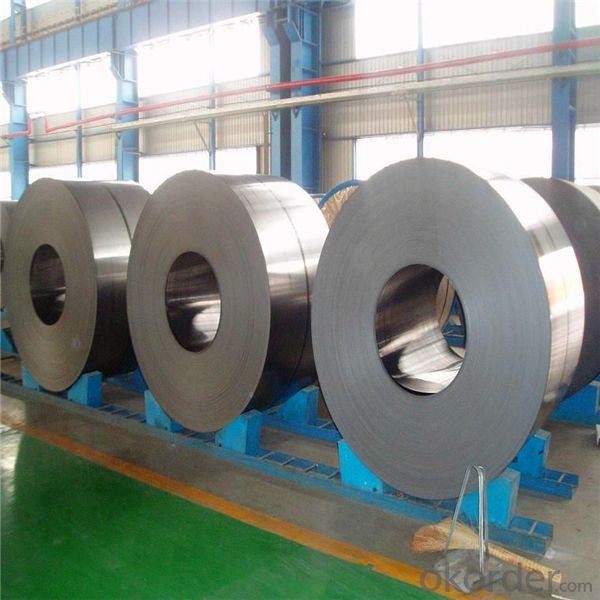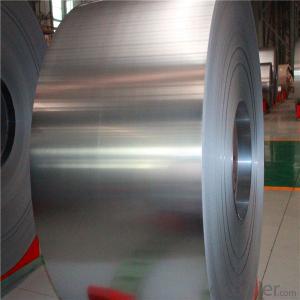Prime Cold Rolled Steel Coils with Low Price China
- Loading Port:
- China main port
- Payment Terms:
- TT OR LC
- Min Order Qty:
- 12 m.t.
- Supply Capability:
- 10000 m.t./month
OKorder Service Pledge
Quality Product, Order Online Tracking, Timely Delivery
OKorder Financial Service
Credit Rating, Credit Services, Credit Purchasing
You Might Also Like
Item specifice
Standard:
ASTM,GB,JIS
Technique:
Cold Rolled
Shape:
Round
Surface Treatment:
Oiled,Bright
Steel Grade:
Q195,Q215,Q235,Q215B,Q235B
Certification:
ISO,SGS,BV,CE
Thickness:
0.18mm-1.8mm
Width:
1000mm-1600mm
Length:
requirement
Outer Diameter:
according to weight
Net Weight:
10MT
Packaging:
Standard Export Packing
| Main Quality Standard | JIS3141, EN10130, DIN1623, ASTM A1008/1008M GB5213 |
| Annealing Type | 20 hydrogen annealing furnaces from Austria EBNER |
| Specification | 0.25mm upto 1.2mm ×900mm upto 1265mm |
| Weight | max 10,000kg |
| Yield Strength | 100 Mpa upto 280 Mpa |
| Products inside Diameter | φ508mm or φ610mm |
| Outer Diameter | max φ2,050mm |
| Packing | export standard packaging; horizontal packaging |
| Capacity | 300,000 tons/year |
Export standard seaworthy packaging
· Axial and circumferential steel straps with seal (4 steel straps each)
· VCI Anti-rust kraft paper
· Water-proofing plastic
· Pearl wool (coil surface)
· Steel cover (coil surface/bore)
· Plastic cover (coil sides)
· Inside and outside corner protectors
The reasons why customers choose us
1.High quality raw material
Our raw material is bought from some famous state-owned steel mills,such as WISCO,Baosteel,Ansteel,Tangsteel,etc.
2.High-precision thickness
The thickness tolerance can be reached +/-0.01mm.
The zinc layer mass range is from 30g/m2 to 275g/m2.
3.Customer-oriented concept
We try our best to find the solutions for customers and finnally meet their needs.
4.Advaned equipment and strict quality inspection
PRODUCT PICTURE


- Q:How are steel coils used in the marine industry?
- Steel coils are commonly used in the marine industry for various purposes such as shipbuilding, offshore structures, and maritime equipment. These coils are utilized in the construction of ship hulls, decks, and bulkheads due to their high strength and durability. Additionally, they are often used in the fabrication of marine equipment such as cranes, winches, and anchor systems. Steel coils are crucial in ensuring the structural integrity and longevity of marine vessels and components, making them an essential material in the marine industry.
- Q:How are steel coils inspected for surface defects after processing?
- Steel coils are inspected for surface defects after processing using various methods such as visual inspection, magnetic particle inspection, dye penetrant inspection, and ultrasonic testing. These techniques help identify any irregularities or defects on the surface of the coils, ensuring the quality and integrity of the final product.
- Q:Can you reload spent casings if they are steel?
- Technically they are reloadable but it's way too much effort and it'll probably cost more to do than its worth. I know you're probably asking this for surp. 7.62x54r right? The steel will have to be fully resized every time and you should only do it 1-2 time max to be safe. Also if your ammo is berdan primed the primers are very hard to find and these are a whole different beast than boxer primed. Short answer is yes but not worth it IMO.
- Q:How would you calculate the maximum plastic deformation (expansion) a steel pipe can handle before it actually fails?
- You can calculate the maximum reversible strain, for elastic loading as follows: You need to look up the yield strength (for that particular type of steel). Divide this yield strength by the elastic modulus of steel (also called Young's modulus). That gives you the strain at the onset of yielding, the maximum you can strain the steel fibers before crossing the point of no return. If you are interested in the strain until failure, you need to take tensile test measurements. Seldom do people document an equation to model the non-elastic portion of the stress-strain curve of the specimen, because seldom do we design systems to operate with materials which yield. We want systems which only deform reversibly and elastically. This means you need to perform an experiment to find what you are actually desiring to know.
- Q:What are the different types of steel coil handling devices?
- There are various types of steel coil handling devices, including coil lifters, coil tongs, coil hooks, coil grabs, and coil carriages.
- Q:How are steel coils protected from mechanical damage?
- Steel coils are typically protected from mechanical damage through the use of various packaging materials such as wooden crates, steel frames, or protective plastic wraps. These measures ensure that the coils remain intact and safeguarded during transportation, handling, and storage, minimizing the risk of any potential mechanical damage.
- Q:What are the different types of corrosion protection for steel coils?
- There are several types of corrosion protection for steel coils, including hot-dip galvanizing, electro-galvanizing, paint coatings, and organic coatings. Hot-dip galvanizing involves immersing the steel coil in a bath of molten zinc, creating a protective layer on the surface. Electro-galvanizing is a similar process, but uses an electric current to deposit a layer of zinc onto the steel. Paint coatings provide a barrier between the steel and the environment, preventing corrosion. Organic coatings, such as epoxy or polyurethane, also provide a protective layer and can be applied by various methods such as spraying or dipping.
- Q:I need details for steel column splices welded or bolted. References or autocad blocks will be very useful. Thank you very much!
- Boy oh boy, that request would open you up to a bunch of different types of files and drawings. There are so many different ways to make a column splice for structural steels. And they all would depend greatly on the loads that the joint will be subject too. You need to find a copy of the Manual of Steel Construction Ninth edition (or newer if its out, mine is the ninth), from the AISC 'American Institute of Steel Construction. This book will show you quite a few different connection options, welded and bolted. You will need to make drawings from the dimensions and details you see in the book. One other thing, you might try to find a manual for steel detailing, the seventh edition of the above book had a section to show detailing dimensions for different steel elements, dependant on the size and shape of the member itself.
- Q:What are the different types of steel coil coatings for heat resistance?
- There are several types of steel coil coatings available for heat resistance. These coatings are designed to protect the steel surface from high temperatures and prevent oxidation or degradation. One common type of coating is the organic coating, which is typically made of epoxy, polyester, or polyurethane. These coatings provide a protective barrier against heat and prevent the steel from corroding or oxidizing. Organic coatings are often used in applications where moderate heat resistance is required. Another type of coating is the inorganic coating, which is typically made of ceramic or metallic materials. These coatings provide excellent heat resistance and can withstand extremely high temperatures. Inorganic coatings are commonly used in industries such as automotive, aerospace, and power generation, where components are exposed to intense heat. There are also specialized coatings available for specific heat resistance requirements. For example, silicone coatings provide exceptional heat resistance and can withstand temperatures up to 600°C (1112°F). These coatings are commonly used in applications such as exhaust systems, ovens, and industrial furnaces. Additionally, some steel coil coatings may contain additives or fillers to enhance their heat resistance properties. These additives can improve the coating's ability to withstand high temperatures and provide better protection against heat-related issues. In summary, there are various types of steel coil coatings available for heat resistance, including organic coatings, inorganic coatings, and specialized coatings. The choice of coating depends on the specific heat resistance requirements of the application, and factors such as temperature range, duration of exposure, and environmental conditions should be considered when selecting the appropriate coating.
- Q:What is the market demand for steel coils?
- The market demand for steel coils is influenced by various factors such as economic growth, construction and infrastructure projects, automotive manufacturing, and consumer goods production. It fluctuates based on these industry trends and overall market conditions. Currently, the market demand for steel coils is significant due to increased construction activities, infrastructure development, and manufacturing needs globally. However, it is important to note that market demand can vary regionally and may be subject to short-term fluctuations based on specific economic and industrial factors.
1. Manufacturer Overview |
|
|---|---|
| Location | |
| Year Established | |
| Annual Output Value | |
| Main Markets | |
| Company Certifications | |
2. Manufacturer Certificates |
|
|---|---|
| a) Certification Name | |
| Range | |
| Reference | |
| Validity Period | |
3. Manufacturer Capability |
|
|---|---|
| a)Trade Capacity | |
| Nearest Port | |
| Export Percentage | |
| No.of Employees in Trade Department | |
| Language Spoken: | |
| b)Factory Information | |
| Factory Size: | |
| No. of Production Lines | |
| Contract Manufacturing | |
| Product Price Range | |
Send your message to us
Prime Cold Rolled Steel Coils with Low Price China
- Loading Port:
- China main port
- Payment Terms:
- TT OR LC
- Min Order Qty:
- 12 m.t.
- Supply Capability:
- 10000 m.t./month
OKorder Service Pledge
Quality Product, Order Online Tracking, Timely Delivery
OKorder Financial Service
Credit Rating, Credit Services, Credit Purchasing
Similar products
New products
Hot products
Hot Searches
Related keywords



























